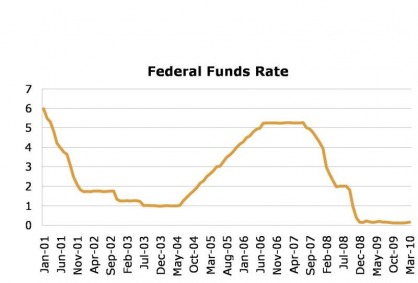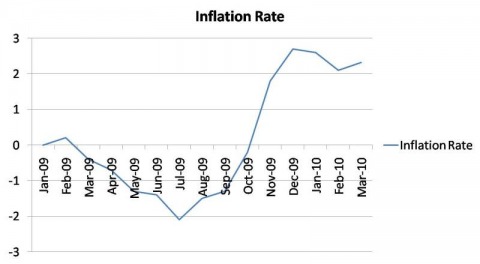Interest Rates & Inflation

Rates Shown in %
Interest rate adjustments are usually the primary means by which the Federal Reserve combats inflationary forces in the economy. With the drastic accommodative policies pursued by the Federal Reserve in response to the financial crisis, many fear that the future economic environment could be ripe for high levels of inflation because of the increased supply of money. To date, the Fed has expanded the monetary base by roughly $1.3 trillion, mostly in order to purchase bonds issued by Fannie Mae & Freddie Mac, as well as long-term treasuries and asset-backed securities issued by corporations.
The economy grew by 3.2% in the first quarter of 2010. If this growth rate of the economy continues or accelerates, and lending increases substantially, the dollar could depreciate and price levels could rise quickly. However, many economist (including an overwhelming majority of those at the Federal Reserve) believe that a protracted period of slow economic growth largely renders the possibility of hyperinflation unlikely in the foreseeable future, though the Fed has maintained that it will continue to monitor market conditions and act accordingly. In fact, at its last meeting, the Federal Reserve Open Market Committee, the group that sets interest rates, reported that it continues to believe that economic conditions are likely to warrant a low federal funds rate for an extended period. As the economic recovery develops, however, the Federal Reserve will inevitably raise both the federal funds and discount rates.
The Federal Reserve also has another important interest rate to consider. In 2008, the Federal Reserve gained the ability to pay bank interest on banks' reserves held in its accounts. Increasing the rate from the current 0.25% would make it more attractive for banks to keep reserves on deposit, giving the Fed the time to drain these funds by selling securities back to the banks. The authority to do this was a minor part of the Troubled Asset Relief Program (TARP) bailout, but is now considered a key part of the Federal Reserve's strategy fo managing the economy; some even say it could eclipse the federal funds rate in the future.
Back to Exit Strategy

